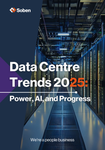Data centers are facing increasing risks from climate change-induced extreme weather, according to a new report from XDI.
The 2025 Global Data Centre Physical Climate Risk and Adaptation Report analyzed 8,868 data centers across the world, finding that climate risks aren’t merely an impending issue for future generations, but a real and present danger.
The report utilized data from Data Center Map to calculate physical climate risks to operational, under-construction, and planned data centers from eight climate change hazards, under a high-emission scenario from now until 2100.
The hazards analyzed include riverine flooding, surface water flooding, coastal inundation, extreme wind, forest fire, freeze-thaw, tropical cyclone wind, and soil movement.
According to the compiled data, at present, 6.25 percent of data centers are viewed as high risk, 15.79 percent as moderate risk, and the remaining 77.97 percent as low risk. By 2050, data centers under high risk increased to 7.13 percent, moderate risk to 19.6 percent, with the remaining 73.27 percent considered low risk.
Climate risks, which are considered at a very high level of concern by the report, include riverine flooding, which risks severe damage to electronics, walls, roofs, and power systems from water ingress, and coastal inundation, which risks buildings being flooded, leading to water damage to cabling.
The report notes that by 2050, major data center hubs such as New Jersey, Hamburg, Shanghai, Tokyo, Hong Kong, Moskva, Bangkok, and Hovestaden are expected to face significant climate risks, with 20 to 64 percent of facilities in these areas likely to be highly vulnerable to physical damage from climate-related events.
The Asia-Pacific region, while leading global data center expansion, is also among the most exposed. In 2025, more than 10 percent of data centers in APAC are considered high risk, a figure projected to rise to more than 12 percent by 2050.
In the US, more than six percent of the 3,382 data centers analyzed are considered to be at high risk by 2050. In 16 states, the percentage increases to 10 percent. The most at-risk states are New Jersey, where one in five data centers could be at high risk, followed by Massachusetts, Oregon, and Michigan.
Virginia, the largest data center hub in the world, is at the lower end of the ranking, with around 3.21 percent of its data centers considered at high risk. However, presently, 16 out of 529 data centers in the state are already at high risk.
Therefore, the report contends that without significant investment in climate resilience, global insurance premiums for data centers could increase three to four times by mid-century.
The report modeled several scenarios to determine the efficacy of adaptation efforts to data center architecture to mitigate the impact of climate-induced events. According to the report, adaptation measures significantly reduced climate risk for data centers by 2050.
The number of high-risk facilities dropped by 72 percent, from 632 to 175, while moderate-risk sites fell by 71 percent, from 1,738 (19.60 percent of the total) to 511 (5.76 percent). Overall, the risk of damage to data infrastructure from climate-related hazards decreased by 74 percent.
The report acknowledges, however, that while structural adaptation can make a significant impact to reduce physical damage risk, it’s not a silver bullet due to the importance of external systems in the operation of data centers. Therefore, the report argues that cross-dependency on things such as power access to the grid, fuel supplies, and site access means that resilience must extend beyond the data center itself.
Things heating up
The XDI paper was not the only recent report to warn of increasing risks from climate change-induced weather. A research paper from Verisk Maplecroft warned that the majority of the world’s top 100 data center hubs are highly exposed to a range of heat-related risks that could severely impact operations.
According to the research, more than half of the world’s top 100 data center hubs are already at high or very high risk from heat-related hazards. This rises to 68 percent by 2040 and 80 percent by 2080 under a high-emissions scenario.
In addition, it reveals that cooling needs in data centers will have to increase markedly, with the Cooling Degree Days Index showing an 83 percent average rise in cooling demand between 2030 and 2080 for the top 100 hubs.
In turn, issues of water stress are expected to skyrocket, with the paper stating that by 2030, 52 percent of global data center hubs will face high or very high water stress – rising to 58 percent by 2050 – due to increased cooling demands and climate-driven water scarcity.
The most at-risk regions pinpointed in the report are MENA, in particular Abu Dhabi, Dubai, and Istanbul; Africa, especially Lagos, Johannesburg, and Nairobi; and the US, with cities including Los Angeles, Denver, and Phoenix, seen as most at risk.
More in Construction & Site Selection
Read the orginal article: https://www.datacenterdynamics.com/en/news/climate-threats-to-data-centers-set-to-surge-report/









